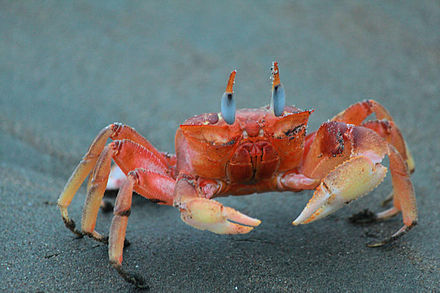Ghost crab
Ghost crabs are semiterrestrial crabs of the subfamily Ocypodinae. They are common shore crabs in tropical and subtropical regions throughout the world, inhabiting deep burrows in the intertidal zone. They are generalist scavengers and predators of small animals. The name "ghost crab" derives from their nocturnality and their generally pale coloration.[1][2] They are also sometimes called sand crabs, though the name refers to various other crabs that do not belong to the subfamily.
Characteristics of the subfamily include one claw being larger than the other, thick and elongated eyestalks, and a box-like body. The differences in claw sizes, however, are not as marked as in male fiddler crabs. The subfamily includes 22 species in two genera.
Ocypodinae is one of two subfamilies in the family Ocypodidae, the other being the fiddler crab subfamily, Ucinae. Both subfamilies have members in which one of the claw-bearing legs (the chelipeds) is much larger than the other. However, only male fiddler crabs exhibit this, while both male and female ghost crabs have unequally sized claws. The difference is also much more pronounced among fiddler crab males. The fiddler crabs' carapaces are broadened at the front, while the carapaces of ghost crabs are more or less box-like. Lastly, the eyes of ghost crabs have large and elongated eyestalks, with the corneas occupying the entire lower part, while in fiddler crabs the eyestalks are long and thin, with the corneas small and located at the tip.[3][4]
Ocypodinae was previously regarded as monotypic, with only one genus, Ocypode, classified under it. In 2013, though, Katsushi Sakai and Michael Türkay reclassified the gulf ghost crab into a separate genus, Hoplocypode based on the differences of their gonopods (appendages modified into copulatory organs) from that of the rest of the members of the genus Ocypode.[5]
Most ghost crabs have pale-colored bodies that blend in well with the sand,[3] though they are capable of gradually changing body coloration to match their environments and the time of day.[6][7] Some species are brightly colored, such as Ocypode gaudichaudii and Ocypode ryderi.[2][5]
Ghost crabs have elongated and swollen eyestalks with very large corneas on the bottom half. Their carapaces are deep and box-like, squarish when viewed from the top with straight or slightly curving sides. The regions of the carapace are usually not clearly defined. The "whip" of their antennules (antennular flagella) are small or rudimentary. They fold back into the body diagonally or almost vertically. The plate between them (the interantennular septum) is broad. The third pair of mouth appendages (maxillipeds) completely cover the mouth opening. A small orifice with edges thickly fringed with hair is found between the bases of the second and third pairs of walking legs.[8]

